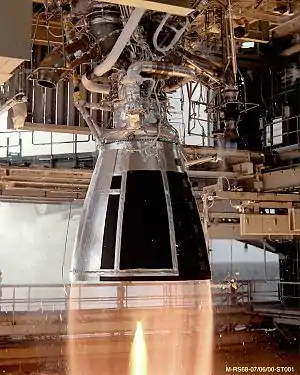Curie (rocket engine)
Curie is a liquid-propellant rocket engine designed and manufactured by Rocket Lab. It uses a "green" monopropellant as its propellant and is used for the third stage/kicker stage of the Electron rocket as well as the Photon.[1] It produces 120 newtons (27 lbf) of thrust, and has an unreleased specific impulse.[2]
| Country of origin | United States |
|---|---|
| First flight | 21 January 2018 |
| Designer | Rocket Lab |
| Manufacturer | Rocket Lab |
| Application | Upper/kick stage |
| Status | In production |
| Liquid-fuel engine | |
| Propellant | Monopropellant |
| Configuration | |
| Chamber | 1 |
| Performance | |
| Thrust (vac.) | 27 lbf (120 N) |
| Restarts | multiple |
| Used in | |
| |
It was first used on 21 January 2018 during Rocket Lab's first successful orbital rocket launch, and helped to boost two small CubeSats, the weather and ship-tracking Lemur-2 CubeSats built by the company Spire Global, into a circular orbit.
Description
The Curie engine, named after Polish scientist Marie Curie, is a small liquid-propellant rocket engine designed to release "small satellites from the constricting parameters of primary payload orbits and enables them to fully reach their potential, including faster deployment of small satellite constellations and better positioning for Earth imaging".[2] It is 3D printed.[3]
Monopropellant version
The Electron third stage, which is powered by Curie, is equipped with its own reaction control system, avionics, power, and communication systems.[3] During the first flight in January 2018 where Curie was tested, the Electron third stage also referred to as the "kick stage", coasted for roughly 40 minutes after successfully deploying an Earth-imaging Dove satellite built by the company Planet Labs, and then ignited the Curie engine on its first in-space test.[3] After this test, the stage was left in orbit. However, Rocket Lab stated that future launches would have the stage deorbited after releasing their payloads to prevent addition to space debris.[4]
While Rocket Lab is not known to have specified the monopropellant used by Curie, in 2012 Rocket Lab demonstrated the use of a non-toxic Viscous Liquid Monopropellant (VLM) that it had developed.
Bi-propellant version
In August 2020 Rocket Lab indicated that the kick stage uses an unspecified liquid bi-propellant fuel for the Curie engine.[5]
See also
References
- "Photon". Rocket Lab. Archived from the original on 4 June 2019. Retrieved 12 May 2019.
- "Rocket Lab successfully circularizes orbit with new Electron kick stage". Rocket Lab. 23 January 2018. Retrieved 23 January 2018.
- Bennett, Jay (23 January 2018). "Rocket Lab Reveals Secret Engine and "Kick Stage" for the Electron Rocket". Popular Mechanics. Retrieved 23 January 2018.
- Clark, Stephen (29 January 2018). "Rocket Lab's test launch carried two previously-unannounced passengers". Spaceflight Now. Retrieved 30 January 2018.
- "Rocket Lab Launch Payload Users Guide 6.5" (PDF). Rocket Lab. August 2020.
- Grush, Loren (2020-06-17). "How small launcher Rocket Lab plans to pull off its first mission to the Moon next year". The Verge. Retrieved 2020-08-13.
